
Did you know that India has 1.2 billion people; therefore, it has more honor students than America has students? My fabulous BrainPOP colleague Andrew Gardner recently returned from a two week trip to India to explore their education system and present on 21st century learning. I’ve been fascinated by his stories and photographs, and invited him to share his stories here on the blog. I’ve taken the photos from Andrew’s photo stream and added my own captions; the rest of the words below are his.
The magazine advertisement made a bold claim: India needs 20,000 new schools each year for the next 10 years. Wow! Ask yourself, how would you build them? How would they be funded? How would you find the teachers? How would you control quality? In light of a newly enacted law asserting all children the right to education, this challenge is reality for the largest democracy in the world.
In January-February 2012, I observed this educational challenge first hand. My father, stepmother, wife and I spent 3 weeks touring the cities of Delhi, Agra, Bangaluru, Chennai, Mumbai, Ahmedebad and Hyderabad. We visited schools, talked with teachers, met professors of education and encountered a wide range of perspectives from government officials, members of NGOs, union representatives, and private sector education reformers. Despite a lot of finger pointing and handwriting we did see successful and effective education ventures put forth by various players in this national game of future building. Did this experience lead to the silver bullet for success? Of course not, but it did prove there are many dedicated people, working hard to do the right thing for the children of this rapidly developing country. Let me share three examples.
Inspirational School Reform Model #1: Muktangan
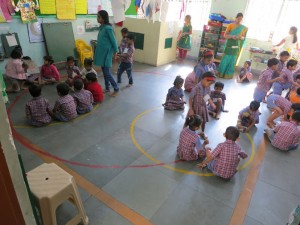
In Mumbai, the “maximum city” that makes New York seem small, I visited an inspirational government school run in conjunction with a community based project called Muktangan. Working with children from a low socio-economic bracket, the teachers at this school employed many of the progressive approaches that I see in the best schools in the US.
Each classroom emphasized developmentally appropriate play. In the kindergarten room I saw 5 year olds wearing colorful costumes and “cooking” in the dramatic play area, while gleeful yelps of excitement came from the young drummers sitting beside. As the teachers transitioned the children from choice time to circle, the 40 students began putting away their materials like a well trained army! They were seated and talking quietly together in no time.
In the 3rd grade room, students were seated on the floor in small groups preparing different re-tellings of the “ugly duckling” story through music, pantomime, writing, and more. Clearly the pedagogical approach at Muktangan valued various expressions of understanding. Interestingly, as a community project, Muktangan is a teacher training center too. Within the school walls, pre-service teachers take classes, observe students, work to develop best practice and connect theory and practice like better schools that I’ve seen in the US. In this school, the teachers carried themselves as real professionals, treating the students, the curriculum and their peers respectfully and with integrity. Needless to say, between the pedagogy, the curriculum and the teacher training, I was impressed with this approach to reforming the system. Note, However, Muktangan works with 7 schools. Remember the numbers I mentioned above?
Inspirational School Reform Model #2: Riverside
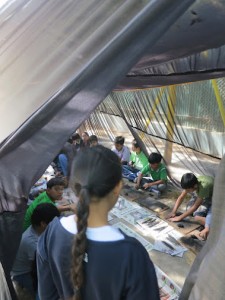
In Ahmedebad, a city famous for Gandhi’s Ashram, we visited Riverside, an independent school known for its charismatic leader, Kiran Sethi and for spearheading “Design for Change”, an international design competition for students. Founded only 11 years ago, in Sethi’s living room, she has worked tirelessly to create an learning community aligned closely with her personal values. The school is divided into three ‘stages’ and our tour of the school was led completely by students from the respective stages.
During our tour, our student tour guides not only explained what was happening in every space, but explained why. A second grader told us, “we are learning about our school community because it is important for us to understand how to work together. If we work together in school, we can work together as a world.” Most unique was the schools approach to helping children build empathy. To learn about forced child labor the 6th grade students sat silently in a ramshackle tent rolling incense sticks for the entire afternoon. We saw a video depicting the same students going through their “normal” class day with one arm literally tied behind their back for the afternoon. These classroom experiences made me think about my own attempts as a teacher to help students build empathy. These effective and immersive experiences would endure far longer than reading The Giving Tree and following up with a discussion!
As we walked through the “3rd stage” upper school buildings, the students pointed out the individual tiles they had laid as they worked with builders to construct the building. They drew our attention to how seamlessly integrated the indoor and outdoor area were designed to make comfortable and effective learning spaces. These students had worked with the architects and builders to make their own school! No wonder they run the contest called “Design for Change!” Embodying the Gandhian spirit, this school was a place where desire for social change and formation of ethical values were at the forefront of the mission. Riverside was a clear example of how an independent school with great leadership can innovate pedagogical approaches. However Riverside, though it seemed to be a ‘world-class’ school, is literally 1 in a million.
Inspirational School Reform Model #3: Naandi
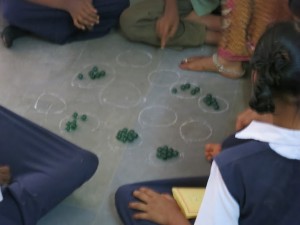
Unlike the well funded and independent Riverside, many government schools are overcrowded and underfunded, with upwards of 70 students in a single class, so its not surprising that many students are unsuccessful and leave school barely literate. Naandi, a Non Government Organization that focusses on education and children’s health, is doing its best to fix this problem. Based in Hyderabad, and led by a strong and thoughtful leader, Manoj Kumar, this organization is addressing a wider scope of educational reform: pedagogy, curriculum, teacher training, health and scale. However, because NGOs cannot run schools directly, they have set up afterschool remedial math and literacy programs.
In the class that we observed on a Saturday afternoon, polite and neatly dressed students worked in small groups, with a “community activist” (not an accredited teacher) trained very specifically in the Naandi approach–the class uses a standardized textbook curriculum. Interestingly, the students were seated on the floor in mixed ability groups, given various manipulatives, (one group was even given unlit matches!) and encouraged to illustrate multiplication facts with the objects. The “community activists”, helped guide the stronger students who in turn helped guide the struggling students. This approach recognizes that heterogeneous peer interaction can be effective for raising the performance level of the most struggling students. This approach also gives the more successful students opportunity to lead and express understanding to help their peers.
Finally, and most subversively, the afterschool Naandi initiative is intended to “trickle down” into the normal class day. Impressive was the documentation by the “community activist” who clearly noted the daily progress for each student/ This Indian style IEP informed the classroom teacher about which groups work well and how to help students advance and build skills.
Summary
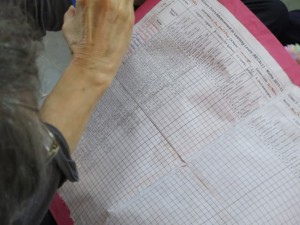
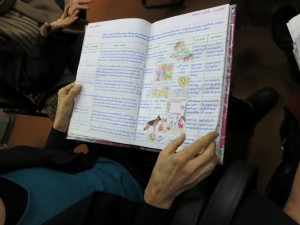
Though I’m sharing the specifics of 3 different reform models, there are countless more developing even as I type! One of the most notable consistencies of the trip was the visibility of colorful school signs with hot ticket phrases like “Montessori,” “Waldorf” and “Arts Based Learning” adorning the thoroughfares of every city. Some of these schools are government run, some for profit, some non-profit: the only common thread is that they are all new.
Clearly people are planting seeds and trying out every conceivable method. The question is – will there be a way of identifying and distributing best practices, once the thousand flowers have had a chance to bloom? Will best practice from one region work in another? Is there any government oversight? More generally, in a democratic market society, how can we encourage experimentation without constantly reinventing the wheel? This is a question we are struggling with in the US too. The three models I’ve described here seem to work with the quite different populations for which they were devised. But with 200,000 schools to build in the next decades– or even 100,000–the possibilities for chaos are real.
For pictures and more commentary, and an opportunity to pose questions, please visit my voice thread. A special thank you goes to the leadership of idiscoveri, the Delhi based educational social enterprise, who sponsored this life changing experience.
Thank you, Andrew for sharing this with us! To learn more, you can view a slideshow with more pictures and video from the schools he visited, or explore the voice thread mentioned above in which Andrew narrates his tour of India–it’s really cool!

Angela Watson
Founder and Writer
Sign up to get new Truth for Teachers articles in your inbox
OR

Join our
community
of educators
If you are a teacher who is interested in contributing to the Truth for Teachers website, please click here for more information.















